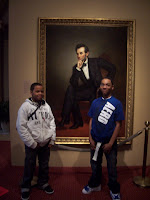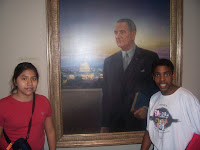We started this month's scavenger hunt with a few questions on prominent presidents. As soon as teams answered the first research questions, they were given the actual scavenger hunt and they rushed off to see who would come back a winner. See the handouts that were posted yesterday.








Clue #1 Saving Nature for All (75 points)
Head to the American Experience section of the American Art Museum and find the Rainbow over the Grand Canyon of the Yellowstone. Thomas Moran painted this great scene 28 years after Yellowstone was made into the first National Park. Just by looking at this painting you can see why a president would want to protect this land for everyone to enjoy. Which president signed the Act of Dedication to create Yellowstone National Park (the first in the nation)?
A) Abraham Lincoln
B) Woodrow Wilson
C) Ulysses Grant
Get a photo of both of you “signing” the answer in front of this painting. Make sure we can see your answer.


Clue #2 Put Down That Weapon (100 points)
Head to the Early Republic section of the American Art Museum and find the statue that connects to this explanation:
As soon as he was done fighting the war he resigned and became a civilian. He said that America should not have an army because that is what kings have to control the people. Instead, he said that we should have a militia of private citizens that can get organized only when necessary. It’s dangerous to have lots of power in the hands of just a few people so we should not have an army at all.
Which president said this?
D) George Washington
E) James Madison
F) Abraham Lincoln
Get a photo of both of you “signing” the answer in front of this statue. Make sure we can see your answer.


Clue #3 Women’s Suffrage (100 points)
Head to the American Origins section of the National Portrait Gallery and find the woman who connects to this description: In 1848 She helped organize the Seneca Falls Convention which was a founding moment of the women’s rights movement. She would fight all her life for women’s suffrage (right to vote) but she would die in 1902, which would be 18 years before women could legally vote. What is her name?
__ __ __ __ __ __ __ __ __
__ __ __ __
__ __ __ __ __ __ __
What president would oversee women getting the right to vote? Do the math!
G) Franklin Delano Roosevelt
H) Woodrow Wilson
I) Lyndon Johnson
Get a photo of both of you “signing” the answer in front of the painting of this woman. Make sure we can see your answer.


Clue #4 Indian Removal Act (75 points)
Head to the Western Art section of the American Art Museum. Find a painting by George Catlin that shows a Native American “Going to and Returning from Washington.” This image shows a change in the lifestyle of Native Americans.
Did you know that Native Americans were forced to move out of their lands? Which president signed the Indian Removal Act seven years before Catlin
created this painting?
J) George Washington
K) James Madison
L) Andrew Jackson
Get a photo of both of you “signing” the answer in front of this painting.
Make sure we can see your answer.


Clue # 5 Separate is not Equal (100 points)
Head to the 20th Century Americans section of the National Portrait Gallery.
Find this man: 1) He was a lead lawyer in the Brown v. Board of Education court case in which his team won. This made segregated schools illegal throughout the nation.
2) He was the head lawyer for the NAACP for many years.
3) He was the first African-American to be appointed to the Supreme Court.
Who was he? _______________________________________
Which President appointed him to the Supreme Court?
M) Abraham Lincoln
N) Franklin Delano Roosevelt
O) Lyndon Johnson
Get a photo of both of you “signing” the answer in front of the painting of this man. Make sure we can see your answer.


Clue # 6 The Black Cabinet (100 Points)
Head to the 20th Century Americans section of the National Portrait Gallery and find the woman who carried a cane because it gave her some “swank.”
This woman saw that during the “New Deal” in 1936 many people were getting jobs except African-Americans. She helped to create the “Black Cabinet” which put pressure on the president to make sure that African Americans had access to jobs from the federal government. This president eventually appointed her to lead the National Youth Administration and she would be the first African American to lead a federal agency.
What president did this?
P) Woodrow Wilson
Q) Abraham Lincoln
R) Franklin Delano Roosevelt
Get a photo of both of you “signing” the answer in front of the painting of this woman. Make sure we can see your answer!


Clue #7 The Primary State (125 points)
Head to the Contemporary Art section of the American Art Museum and find the neon map of America.
Now find the state that hosts one of the first primaries in national politics. It is the one state flashing the faces of at least ten presidents. Winning this state is very important to presidential hopefuls because it shows that they can debate well and win votes with their ideas.
Once you’ve found the state, have one partner shoot a short video in which he or she acts like a reporter and explains:
1) Why this state is so famous for politics…
2) …and names at least two presidents that you see on the screen.
Be sure to show the state in the video!
Clue #8 Our Founding Documents (100 points)
Near the Museum Store you will find a curious piece of artwork that relates to automobiles.
If you read this piece of work out loud you will be reciting the words of our nation’s Constitution, which was mainly written by our fourth president.
Who was the main author of our Constitution?
A) George Washington
B) James Madison
C) Andrew Jackson
Get a photo of both of you “signing” the answer in front of this piece of artwork. Make sure we can see your answer!


Clue #9 Putting People to Work (100 points)
Head to the WPA section of the American Art Museum to see some of the art created during the Great Depression. Our Thirty-Second president was faced with one of the biggest economic issues in the history of the world. This depression lasted from 1929-1939 and this president created the Work Projects Administration to put people to work and to try to stop this depression. Much of the art created in the WPA showed people at work and the greatness of our land. Find an example of this work by Thomas Hart Benton
Who was the president who created the WPA to end the Depression?
U) Lyndon Johnson
V) Abraham Lincoln
W) Franklin Delano Roosevelt
Get a photo of both of you “signing” the answer in front of this piece of artwork. Make sure we can see your answer!


Clue #10 Inauguration Party Central (100 points)
Our 16th president has become our most famous for many good reasons like keeping the country together during the Civil War and ending slavery. Did you know that this president also had his inaugural ball in the building you are now in? Head upstairs to the Portico Café and find the room devoted to his inauguration and find a large picture showing his inaugural ball.
Which president had his inaugural ball in this building?
x) Lyndon Johnson
y) Abraham Lincoln
Z) Ulysses Grant
Get a photo of both of you “signing” the answer in front of this photo. Make sure we can see your answer!


Bonus Corner
1) 50 points for shooting a short video of you and your partner trying to learn the dance steps on the floor.
2) 50 points for a picture of you both in front of our newest president.


3) 50 points for capturing video of one of you acting like a reporter and explaining what is going on in the courtyard today and how it connects to one of our most famous presidents. You must have footage of the presentation happening at 12 or 2.